6 Agaricus
This important group, which includes the familiar supermarket variety, is easily recognized by the features shown in the photo on this page: the gills are free from the stalk and dark chocolate-brown at maturity (but white or pink when young), and they are covered at first by a veil which usually forms a ring on the stalk after breaking. In addition, the spores are the color of unsweetened chocolate (the ring in the photo is coated with spores).
Distinguishing among different species of Agaricus can be tricky, because most have the same overall appearance (white or brown cap, white stalk, and the above-mentioned features). As both delectable and mildly poisonous species (see this page) occur, a large selection is included here. It is easily the most difficult section of this book, requiring a keen eye and sensitive nose, so seek out experienced help if possible. Your efforts will be rewarded, because no group of gilled mushrooms offers more fine edibles, many of which are plentiful in urban as well as rural habitats. For a more comprehensive treatment, see MD 310–341.
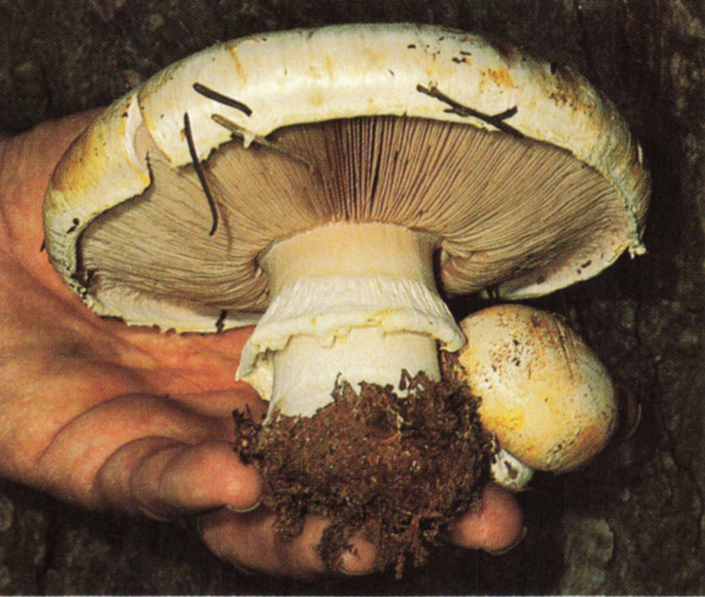
Agaricus albolutescens (see “Note” on this page).
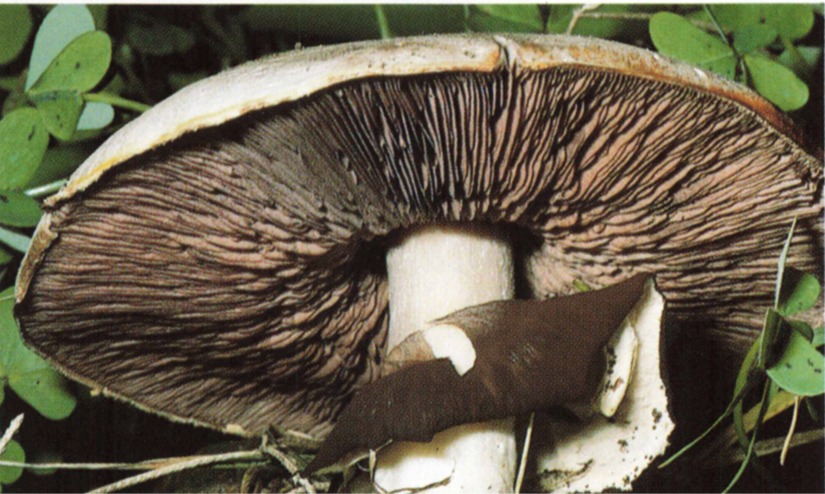
Woodland Agaricus (Agaricus silvicola)
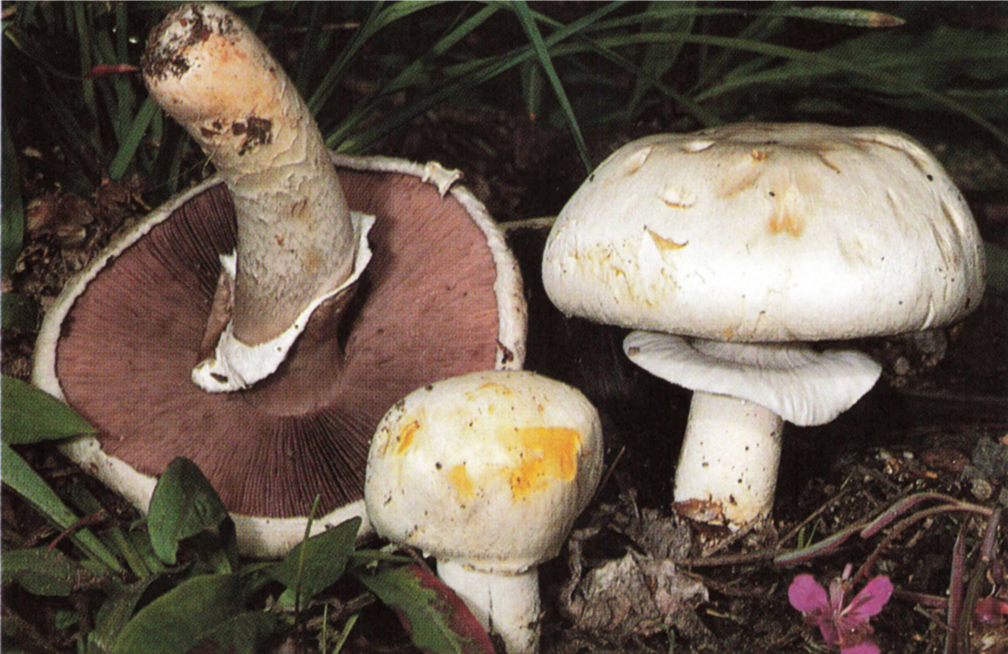
Key Features:
1. Cap white to yellowish, not sticky or slimy
2. Edge of cap staining and remaining yellow when surface is rubbed repeatedly.
3. Gills free from stalk, pale when young, eventually becoming dark chocolate-brown.
4. Odor of crushed flesh sweet (like almond extract or anise), especially when young.
5. Stalk usually partly hollow or stuffed with a pith.
6. Veil present, at first covering the gills, then forming a skirtlike ring on stalk.
7. Base of stalk without a volva (cup or sack), the tip yellowing only slightly if at all when cut.
8. Spores chocolate-brown.
9. Growing in woods.
Other Features: Medium-sized; cap usually bald; stalk white, smooth or slightly scaly, with or without a bulb at base; veil often with patches on underside.
Where: Alone or in small groups on ground in woods and at their edges; common and widespread.
Edibility: Delicious, but be sure not to confuse it with the deadly poisonous destroying angel!
Note: Several edible woodland species have the above features. One, A. albolutescens (shown on this page), is very fragrant and quickly stains amber when bruised. The poisonous yellow stainer has a phenol odor and yellow-staining stalk base, while the horse mushroom grows in grass. See MD 334–336 for more information.
Giant Horse Mushroom (Agaricus osecanus & A. nivescens)

Key Features:
1. Medium-sized to large (cap >3″ broad, stalk >¾″ thick).
2. Cap white to slightly yellowish, not sticky or slimy.
3. Edge of cap yellowing only slightly if at all when surface is rubbed repeatedly.
4. Gills free from stalk, pale when young, eventually becoming dark chocolate-brown.
5. Veil present, at first covering the gills, then forming a prominent ring on stalk.
6. Stalk solid or nearly solid inside.
7. Base of stalk without a volva (cup or sack), the tip not staining bright yellow when cut.
8. Growing in grass.
Other Features: Cap smooth or warty; odor of crushed flesh faintly sweet when young; stalk bald or with a few scales, without a bulb at base (but may be swollen above base); spores chocolate-brown.
Where: In pastures and other grassy or open places, often in groups; common on West Coast (especially during spring in coastal pastures), perhaps more widely distributed.
Edibility: Delicious, especially when young and firm.
Note: The above features apply to several large edible mushrooms of open places that differ microscopically (including A. crocodilinus, shown on this page). As a rule they are more robust than the horse mushroom (this page) but not as fragrant. The cap can be smooth or warty depending on exposure to wind and sun; the tip of the stalk never stains bright yellow as in the yellow stainer. See MD 333–334 for more information.
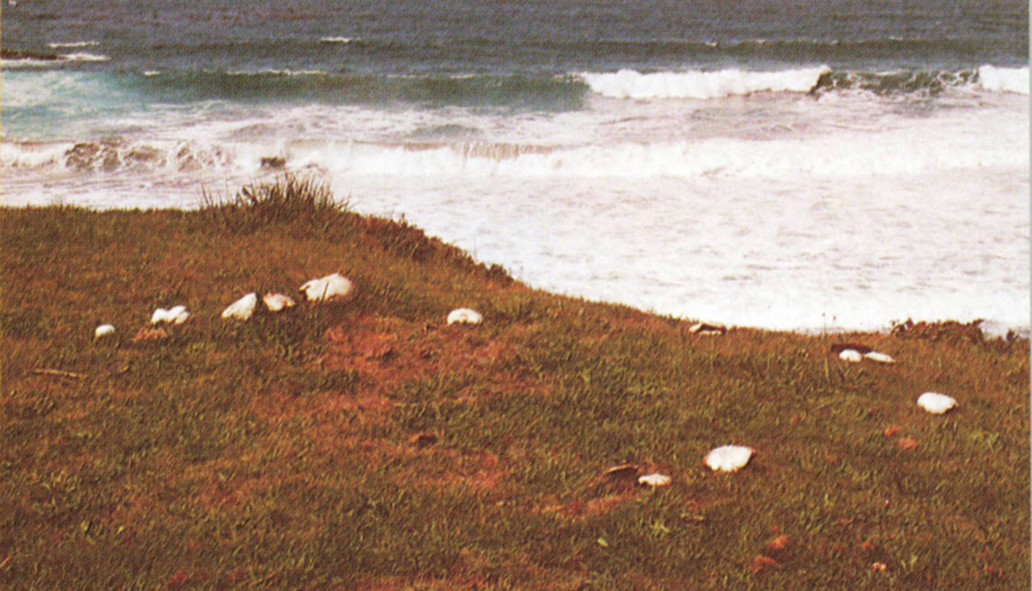
Have Fence, Will Trespass
I was speeding up the coast, late for an important date. The lush green hills were brushed dark to light by gusts of wind like a pool table before the opening break. It was while scanning the meadows, thinking of Ireland, that I saw them: salt licks? paper plates? a flock of migrating geoducks? Some people use binoculars for confirmation, others prefer pellet guns and see if the sightings go baaaaaa…but I just knew. So what if I stopped? I was already late, and they were beauties: white, naked, shivering in the wind. The only thing between them and my belly was a mean little barbed wire fence…
—El Bo
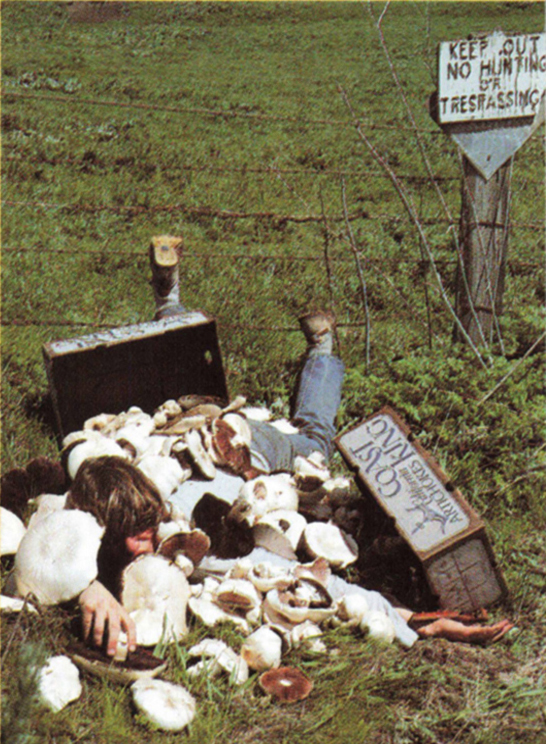
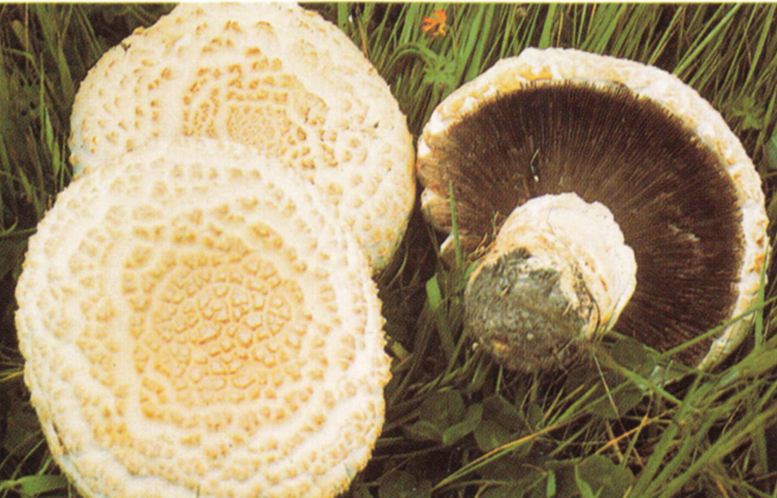
The crocodile agaricus, Agaricus crocodilinus (see “Note” on this page).
Horse Mushroom (Agaricus arvensis)

Key Features:
1. Cap white to yellowish, medium-sized (mostly 2–6″ broad), not sticky or slimy.
2. Edge of cap staining and remaining yellow when surface is rubbed repeatedly.
3. Gills free from stalk, pale when young, eventually becoming dark chocolate-brown.
4. Odor of crushed flesh sweet (like almond extract or anise), especially when young.
5. Stalk usually partly hollow or stuffed with a pith.
6. Veil present, at first covering the gills, then forming a skirtlike ring on stalk.
7. Base of stalk without a volva (cup or sack), the tip not staining bright yellow when cut.
8. Growing in grass.
Other Features: Cap usually bald; stalk white, bald or with a few small scales; underside of unbroken veil usually with a cogwheel pattern of patches; spores chocolate-brown.
Where: Common in lawns, cemeteries, golf courses, and other grassy areas, less frequent in pastures; widespread.
Edibility: Delicious; it is sweeter than the giant horse mushroom, but don’t confuse it with a poisonous amanita!
Note: This popular edible species is usually smaller, yellower, and more fragrant than the giant horse mushroom. It resembles the woodland agaricus but grows in grass. On lawns it often mingles with poisonous species of Agaricus, but the sweet odor and permanent yellowing of the cap distinguish it. See MD 332–333 for more information.
Almond Mushroom (Agaricus subrufescens)
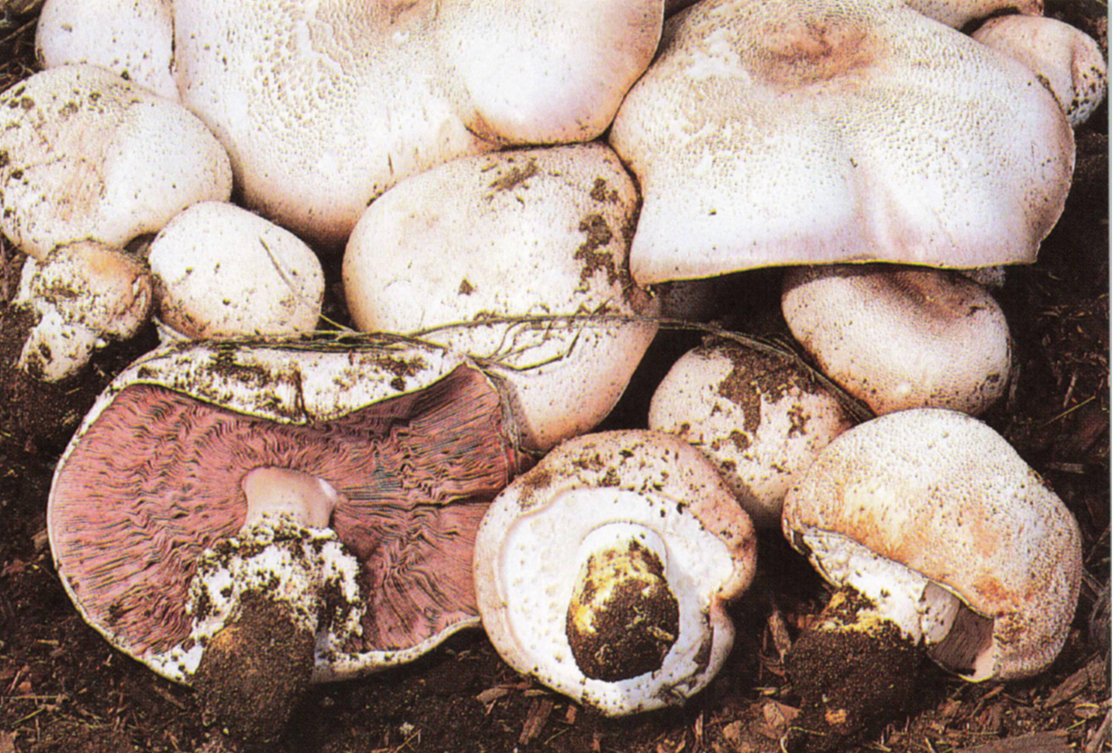
Key Features:
1. Cap white to tan with small light brown fibers or scales.
2. Edge of cap staining and remaining yellow when surface is rubbed repeatedly.
3. Odor strongly sweet (like almond extract), at least when flesh is crushed.
4. Gills free from stalk, pale when young, dark chocolate-brown when older.
5. Stalk not sheathed with prominent scales.
6. Veil present, at first covering the gills, then forming a skirtlike ring on stalk.
7. Base of stalk without a volva, staining pale yellow or orange-yellow when crushed.
8. Growing in grass or rich soil but not in woods.
Other Features: Medium-sized to fairly large; unbroken veil with patches on underside; spores chocolate-brown.
Where: In lawns, gardens, and manured soil during warm weather; common in southern California, otherwise rare.
Edibility: Excellent — the most almondy agaricus, even sweeter than the prince!
Note: This mushroom can be grown at home in the shade of leafy summer vegetables. It was cultivated commercially at the turn of the century but lost out to the “supermarket mushroom,” A. bisporus. The robust, clustered specimens in the photograph grew in manure; those in grass are usually smaller and scattered. See MD 336–337 for more information.
Prince (Agaricus augustus)

Key Features:
1. Cap with brown to golden-brown fibers or scales, at least 3″ broad when mature.
2. Cap marshmallow-shaped when young (before veil breaks).
3. Edge of cap staining and remaining yellow when surface is rubbed repeatedly.
4. Odor sweet (like almond extract), at least when flesh is crushed.
5. Gills free from stalk, white when young, dark chocolate-brown in old age.
6. Veil present, white, covering the gills at first, then forming a skirtlike ring on stalk.
7. Stalk at least ½″ thick, sheathed with scales below the veil (at least when young).
8. Base of stalk without a volva, the tip yellowing only slightly if at all when cut.
Other Features: Medium-sized to very large; cap eventually flat, not sticky or slimy; base often deeply buried; veil with patches on underside; spores chocolate-brown.
Where: On ground in woods (usually near roads or trails) and in disturbed areas or rich soil, often in groups or clumps; widespread but rare except on the West Coast. In the coastal fog belt it fruits in the summer when other fungi are scarce.
Edibility: One of the very best! The sweet fragrance and flavor are a real treat.
Note: The almondy odor, shaggy stalk (see photo on this page), and yellow staining of the cap are most obvious when young. Frisbee-sized mature caps are not uncommon. A. smithii and A. perobscurus are closely related edible species. See MD 337–340 for more information.
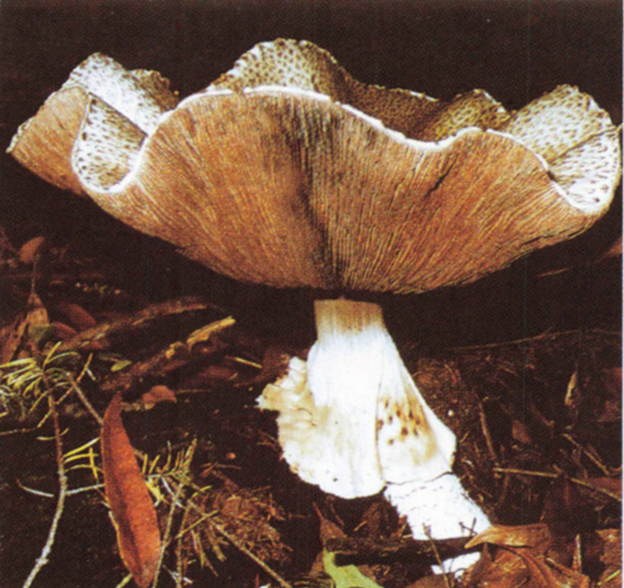
“Spore prince”: a fully mature A. augustus shedding its spores.
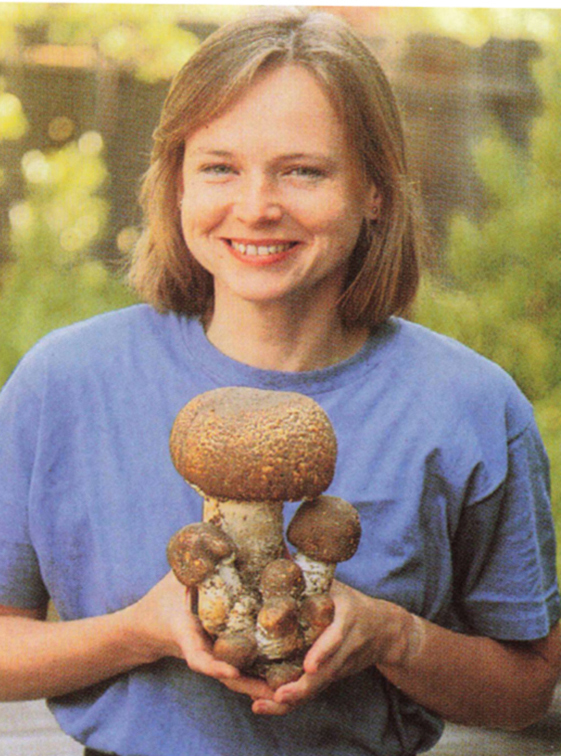
This woman has found her Prince Charming.
A Regal Repast
“August: Inspiring Awe or Admiration”
This majestic mushroom is my favorite, a culinary and aesthetic delight. The flavor is strong, nutty, and sweet like almonds, and if you are blessed with a cluster, it will make the best cream of mushroom soup on the planet.
Wipe the mushrooms clean, slice thinly (don’t soak in water!), and saute in butter or a mild oil. Pour off and save the liquid essence they produce, and continue to cook until almost dry. Douse with David Bruce Santa Cruz Mountains Chardonnay (just a splash; save the rest to sip while you eat) and cook again until almost dry. Sprinkle with a little flour. Cook 1 minute, stirring constantly, and add the reserved essence plus a bit more water or mild stock. Simmer ½ hour, uncovered, allowing it to reduce. Add salt, white pepper, and milk or cream to taste (excellent also without the milk or cream), then serve or reduce further for a delicious sauce over pasta, fish, or vegetables. And please invite me over for dinner!
—Judith Scott Mattoon

A princely cluster; note the shaggy stalks.
Flat-topped Agaricus (Agaricus praeclaresquamosus)

Other Names: Agaricus meleagris.
Key Features:
1. Cap with brown to inky gray fibers or small scales (at least at the center), not sticky or slimy.
2. Young cap marshmallow-shaped (with flattened top).
3. Gills free from stalk, whitish when young (sometimes pink after veil breaks), then dark chocolate-brown.
4. Stalk without scales, often curved above base.
5. Veil present, at first covering the gills, then forming a prominent ring on stalk.
6. Base of stalk without a volva, the tip typically staining bright yellow when cut (see photo on this page).
7. Crushed flesh with an unpleasant antiseptic odor (like phenol or paste), especially in base of stalk.
8. Growing in woods or near trees.
Other Features: Medium-sized to large; cap eventually flat, surface occasionally yellowing when rubbed (but then turning brownish later); veil fairly thick; spores chocolate-brown.
Where: On ground in woods and at their edges, and under trees, often in groups; widespread, but especially common in California and the Pacific Northwest.
Edibility: Poisonous to many, causing stomach distress.
Note: This handsome mushroom is sometimes mistaken for the prince. It does not smell almondy, however, and is smooth-stalked rather than shaggy. One variant does not stain bright yellow in the stalk base, but can still be recognized by the other features listed above. For more details, see this page and MD 329.
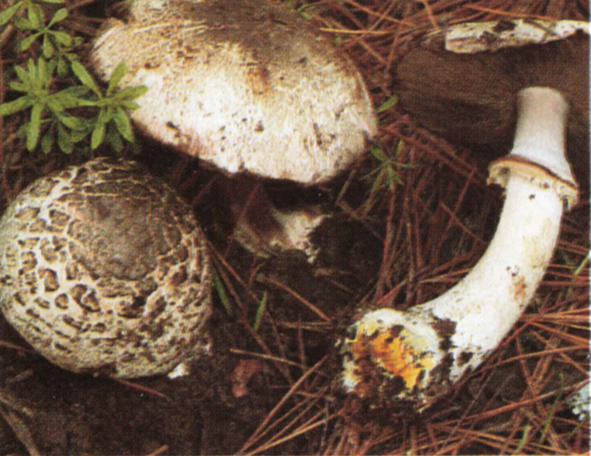
A. praeclaresquamosus (this page)
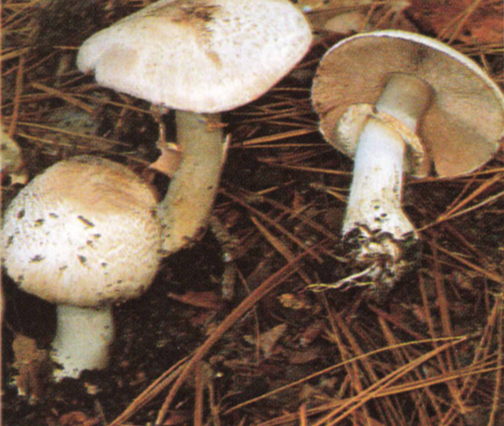
A. hondensis (this page)
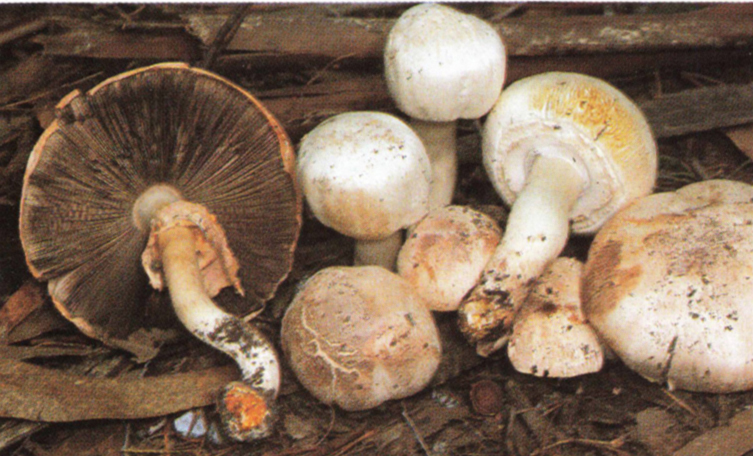
A. xanthodermus (this page)
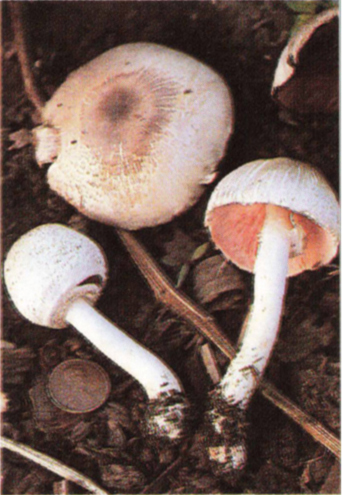
A. californicus (this page)
The Lose Your Lunch Bunch
These four poisonous species of Agaricus are frequently mistaken for edible look-alikes. Also known as the “Foolgoof Four” (as opposed to the so-called “Foolproof Four”; actually, no mushrooms are foolproof, though dozens are intelligence-proof), they can be distinguished from edible species of Agaricus by their unpleasant odor (like phenol or library paste, strongest when the base of the stalk is crushed). Also, the stalk base often has a crook above it, and in two of the four it stains bright yellow when nicked.
Some people with a poor sense of smell prefer to use a simple chemical test: a weak solution of Drano or potassium hydroxide stains the cap surface of the Lose Your Lunch Bunch yellow, but does not stain the cap of the meadow mushroom (A. campestris) and several close relatives. This same test, however, also produces a yellow reaction in the fragrant edible species that naturally stain yellow (such as the prince and horse mushroom). Fortunately, should you munch on one of the Lose Your Lunch Bunch, the consequences aren’t serious: stomach distress that subsides once the ingested offender has been expelled.
Yellow Stainer (Agaricus xanthodermus)
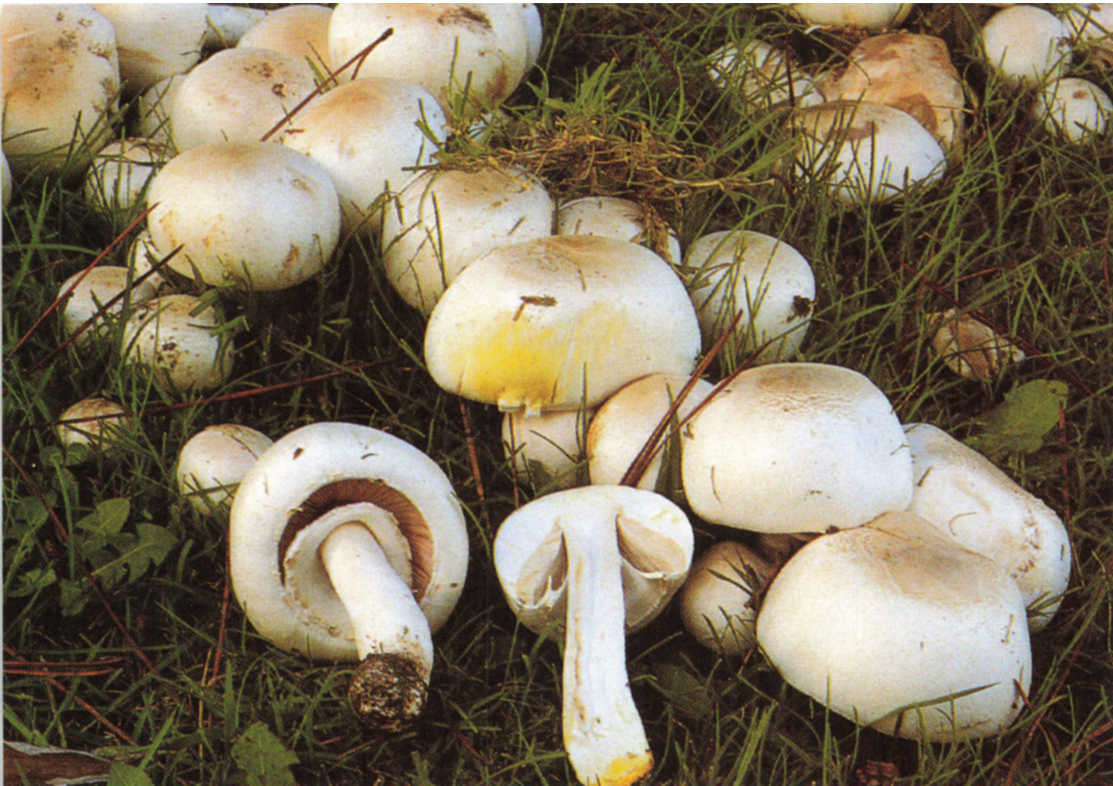
Other Names: Yellow-staining Agaricus, Yellow-foot.
Key Features:
1. Cap white to tan, not sticky or slimy.
2. Edge of cap staining bright yellow when surface is rubbed repeatedly, then later staining brownish.
3. Gills free from stalk, white at first, becoming pinkish after veil breaks, then dark chocolate-brown.
4. Stalk without scales, often curved above base.
5. Veil present, at first covering the gills, then forming a prominent ring on stalk.
6. Base of stalk without a vol va, the tip instantly staining bright yellow when cut.
7. Crushed flesh with an unpleasant antiseptic odor (like phenol or paste), especially in base of stalk.
Other Features: Medium-sized; young cap domed or marshmallow-shaped, the edge usually tucked under when young; cap surface bald or somewhat scaly; spores chocolate-brown.
Where: Widespread in lawns, gardens, woods, orchards, pastures, and along roads, often in large groups; one of the most abundant urban and rural mushrooms in California.
Edibility: Poisonous to many, causing gastrointestinal distress. The cooked mushroom smells and tastes foul.
Note: Several species of Agaricus stain yellow, but none more dramatically than this one. The extreme base of the stalk always stains bright yellow when nicked, and the cap surface typically yellows also. See this page for another photo and more details; also see MD 329–331.
Mock Meadow Mushroom (Agaricus californicns)

Other Names: California Agaricus, Fool’s Agaric.
Key Features:
1. Cap whitish to brown, bald or with fibers or scales, not sticky or slimy.
2. Edge of cap not yellowing when surface is rubbed repeatedly, usually tucked under when young.
3. Gills free from stalk, at first whitish, becoming pink after veil breaks, then dark chocolate-brown.
4. Flesh staining slightly if at all when cut and rubbed.
5. Stalk without scales, usually <½″ thick at top, often curved above base.
6. Veil present, at first covering gills, then forming a prominent, persistent ring on stalk.
7. Base of stalk often swollen but without a volva, the tip not staining bright yellow when cut.
8. Base of stalk with slightly unpleasant antiseptic odor when crushed (like phenol or paste).
Other Features: Small to medium-sized; young cap domed or marshmallow-shaped; cap often whitish with a brown center, often with metallic sheen; spores chocolate-brown.
Where: In lawns, gardens, under trees, or in woods; abundant in California but probably more widespread.
Edibility: Poisonous to many, causing stomach upsets.
Note: This ubiquitous species can be mistaken for the meadow or brown meadow mushroom but has a prominent ring, frequently crooked stalk, whitish gills before the veil breaks, and slightly unpleasant odor. Other members of the “Lose Your Lunch Bunch” are larger. See this page and MD 327–328.
Brown Meadow Mushroom (Agaricus cupreobrunneus)

Other Names: Brown Field Mushroom.
Key Features:
1. Cap brown and fuzzy or hairy, not sticky or slimy.
2. Gills free from stalk, pink before and soon after veil breaks, then becoming dark chocolate-brown.
3. Veil present, at first covering gills, but forming little or no ring on stalk; ring, if present, not skirtlike.
4. Stalk typically without a crook above base; base without a volva (cup or sack) or bulb.
5. Base of stalk with a mild or mushroomy odor when crushed (i.e., not noticeably unpleasant or sweet).
6. Extreme base (tip) of stalk not staining yellow when cut.
7. Growing in grass.
Other Features: Small to medium-sized; cap domed at first, not yellowing when rubbed, edge projecting beyond gills; flesh fragile, not typically staining when cut but may redden slightly with age or wet weather; spores chocolate-brown.
Where: In pastures and other grassy or open places, often in large numbers; widespread, but especially abundant on West Coast. It often grows with the meadow mushroom but seems better suited to poor soils.
Edibility: Edible but fragile and perishable.
Note: Though plentiful, this mushroom is smaller, more fragile, and often dirtier than the meadow mushroom. See MD 319 for more information.
An Agaricus fancier named Clyde
(Loved campestris baked, raw, even deep-fried)
Said, “My, I really feel rotten —
I fear that I’ve forgotten
To test with KOH!”
—Charles Sutton
Meadow Mushroom (Agaricus campestris)

Other Names: Field Mushroom, Pink Bottom, Champignon.
Key Features:
1. Cap white, sometimes with scattered brown fibers or scales, not sticky or slimy
2. Gills free from stalk, pink before and soon after veil breaks, then becoming dark chocolate-brown.
3. Flesh not staining appreciably when cut and rubbed.
4. Veil present, at first covering gills, but forming little or no ring on stalk; ring, if present, not skirtlike.
5. Stalk typically without a crook above base.
6. Base of stalk without a volva (sack or cup) or bulb, the tip not staining yellow when cut.
7. Base of stalk with a mild or mushroomy odor when crushed (i.e., not noticeably unpleasant or sweet).
8. Growing in grass.
Other Features: Medium-sized; young cap domed; cap not normally yellowing when rubbed, edge projecting beyond gills; stalk usually tapered at base; spores chocolate-brown.
Where: In lawns, cemeteries, alpine meadows, and other grassy areas, often in groups or rings; cosmopolitan. “Champignonship” crops most often appear in grazed pastures.
Edibility: A popular favorite, even among staunch fungophobes such as the English.
Note: The pink-gilled “buttons” are as lovely as they are delicious. Unfortunately, on California lawns they often mingle with poisonous look-alikes. In the mock meadow mushroom and yellow stainer there is a ring on the stalk and often a crook near the base, and the gills do not turn pink until after the veil breaks. See MD 318 for more information.
Felt-ringed Agaricus (Agaricus hondensis)
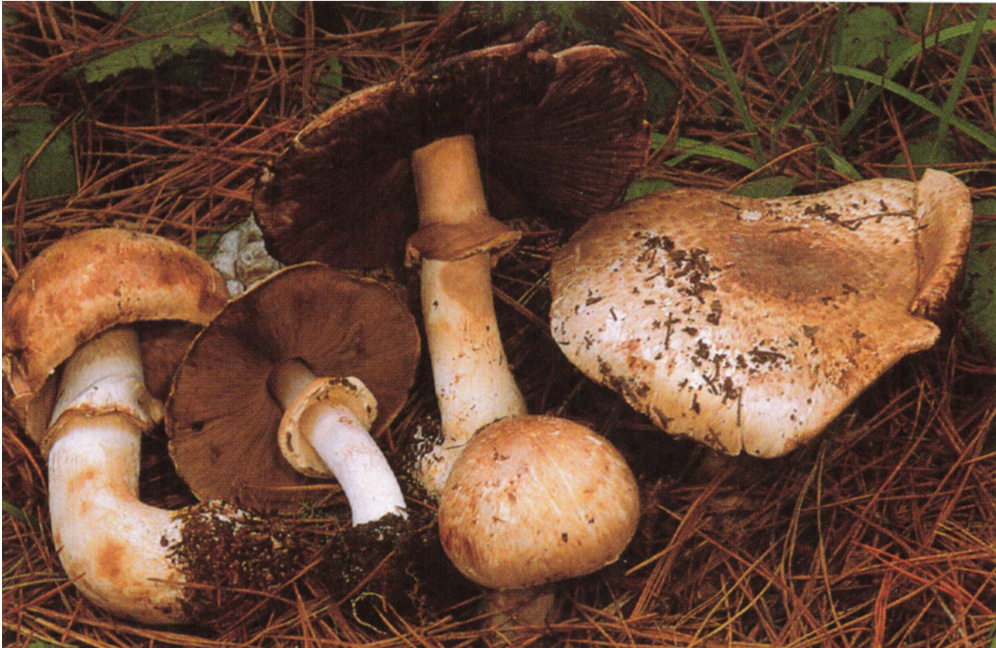
Key Features:
1. Cap with pale tan, brown, or reddish-brown fibers or small flattened scales; surface not sticky or slimy and edge not yellowing quickly when rubbed.
2. Gills free from stalk, whitish or pinkish when young, dark chocolate-brown when older.
3. Flesh not reddening immediately when cut and rubbed.
4. Stalk without scales, at least ½″ thick at top, often with a crook above base.
5. Veil present, at first covering the gills, then forming a thick, felty ring on stalk.
6. Base of stalk without a volva, the tip staining yellow only slightly if at all when cut.
7. Base of stalk with an unpleasant antiseptic odor when crushed (like phenol or paste).
8. Growing in woods or under trees.
Other Features: Medium-sized; cap domed at first; stalk base usually thickened or swollen; spores chocolate-brown.
Where: On ground in woods and under trees, often in groups or rings; common on the West Coast. It tolerates cold weather better than most species of Agaricus.
Edibility: Poisonous to many people, causing gastrointestinal distress. It develops a strong phenol odor while cooking and has an unpleasant, slightly metallic taste.
Note: This handsome forest mushroom has several look-alikes with reddening flesh and a pleasant odor. The wine-colored agaricus is also similar but has a shaggy stalk. For another photo and more details, see the “Lose Your Lunch Bunch” on this page, and MD 326–327.
Wine-colored Agaricus (Agaricus subrutilescens)

Other Names: Woolly-stemmed Agaricus.
Key Features:
1. Cap covered with purple-brown or wine-brown fibers or scales, not sticky or slimy, not yellowing when rubbed.
2. Gills free from stalk, whitish at first, then becoming pink and finally dark chocolate-brown.
3. Flesh not reddening or yellowing when cut and rubbed repeatedly.
4. Veil present, at first covering the gills, then forming a thin skirtlike ring on stalk.
5. Stalk sheathed with shaggy white scales below veil.
6. Base of stalk without a volva, the tip not staining bright yellow when cut.
7. Odor mild or pleasant when base of stalk is crushed (not smelling like phenol, paste, or almond extract).
8. Growing in woods.
Other Features: Medium-sized; stalk thick or slender; spores chocolate-brown.
Where: On ground in woods and at their edges; common from the rain forests of the Pacific Northwest to the oak and pine woodlands of southern California.
Edibility: Edible for most people but mildly poisonous to some (causing gastrointestinal distress).
Note: Both slender and robust forms occur. The distinctive shaggy white sheath on the stem is most obvious when young, before the mushroom is handled. In older specimens the sheath may be obliterated, leading to confusion with the poisonous felt-ringed agaricus or other species. See MD 326 and plate 75.
Alpine Bleeder (Agaricus amicosus)
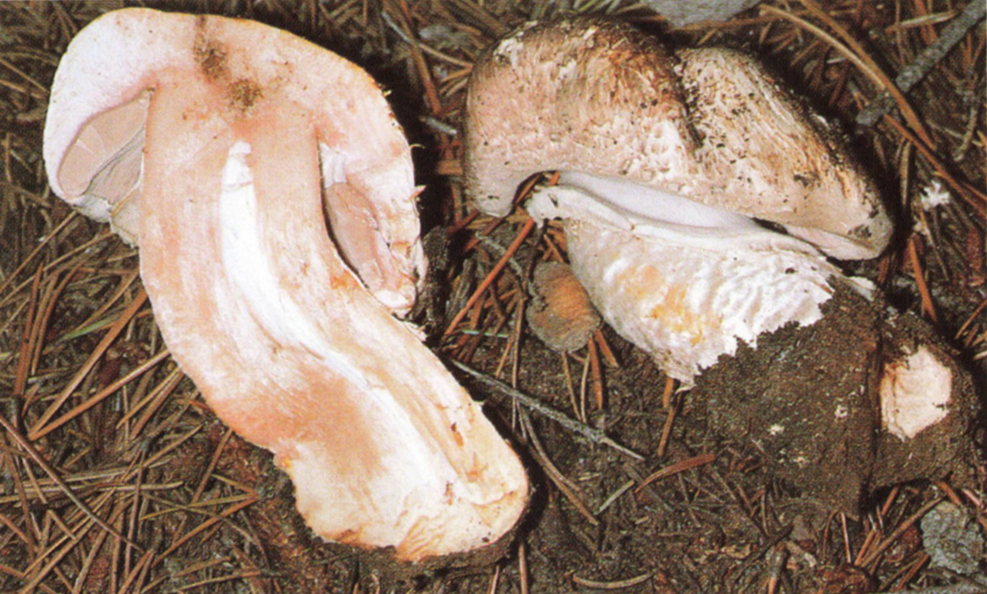
Key Features:
1. Medium-sized (cap 2–7″ broad, top of stalk usually <1″ thick).
2. Cap covered with tan to brown fibers or scales, not sticky or slimy.
3. Gills free from stalk, pinkish when young, eventually becoming dark chocolate-brown.
4. Flesh reddening when cut and rubbed repeatedly (especially at juncture of cap and stalk).
5. Veil present, covering the gills at first, then forming a skirtlike ring on stalk.
6. Base of stalk without a volva, the tip not staining bright yellow when cut.
7. Growing under mountain conifers.
Other Features: Stalk bald or slightly scaly, hollow or stuffed with a pith; odor of crushed flesh mild or pleasant (not like phenol or paste); spores chocolate-brown.
Where: On ground under spruce and fir, often in groups or rings; presently known from the mountains of Colorado and New Mexico, where it is common, but probably found in adjacent states.
Edibility: Presumably edible.
Note: There are several medium-sized, red-staining Agaricus species (or “bleeders”) with a skirtlike ring. They can be difficult to differentiate, but fortunately none are known to be poisonous. Three are shown below; others include A. fuscofibrillosus (MD plate 74), common in coastal California under cypress, and A. silvaticus, found under conifers in the Pacific Northwest. See MD 324–326 for more information.

A. fuscovelatus is fairly common in California, especially under cypress. It can be recognized by its purplish or chocolate-colored veil and tendency to stain orangish or reddish (at least slightly) when cut.
Other Bleeders

A. arorae is a small, slender inhabitant of coastal California that “bleeds” readily like its namesake when cut. It is closely related to A. amicosus in that both stain yellow in potassium hydroxide, whereas most “bleeders” do not.

This firm, robust, delicious mushroom is common along roads in Alaska. It is Agaricus vaporarius, or a similar, perhaps unnamed species.
Giant Cypress Agaricus (Agaricus lilaceps)
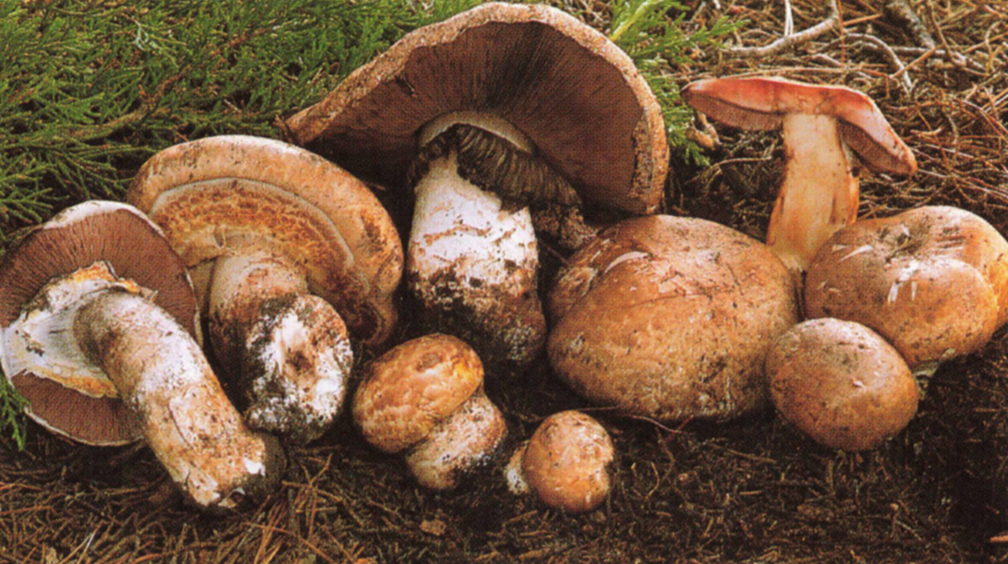
Key Features:
1. Medium-sized to large (mature cap at least 3″ broad).
2. Cap normally brown (but see note below), bald or with fine fibers, not sticky or slimy.
3. Gills free from stalk when mature, pinkish when young, dark chocolate-brown when older.
4. Stalk at least 1″ thick, of equal width throughout or slightly thicker below, not scaly.
5. Flesh thick, firm, staining at least slightly reddish or dull burgundy when cut and rubbed repeatedly.
6. Veil present, covering gills for a long time (until mature), finally forming a thin skirtlike ring on stalk.
7. Base of stalk without a bulb or volva, not staining bright yellow when cut.
8. Base of stalk with mild or fragrant odor when crushed (not unpleasant).
9. Usually growing near cypress.
Other Features: Young cap broadly domed; unbroken veil often with yellow or brown patches; odor of crushed flesh mild or fragrant (not unpleasant); spores chocolate-brown.
Where: On ground under mature Monterey cypress or sometimes other trees, often half-buried, uncommon. At present it is known only from coastal California, but perhaps readers will find it in new localities!
Edibility: Delicious — one of the best!
Note: This marvelous, meaty mushroom deserves to be better known. Under certain conditions the normally brown cap can develop striking orange, yellow, pink, or lilac hues. Another robust red-stainer, A. pattersonae, has a scalier stalk with a bulb. A. bernardii can be large, but has a different kind of ring and habitat; the poisonous A. hondensis often grows under cypress but has a thicker ring and unpleasant odor. See MD 323–324 for more information.
Salt-loving Agaricus (Agaricus bernardii)

Key Features:
1. Cap white to tan, not sticky or slimy.
2. Gills free from stalk at maturity, pinkish or brown before veil breaks, dark chocolate-brown when older.
3. Flesh thick, very firm, staining orange, reddish, or dull wine-red when cut and rubbed repeatedly.
4. Stalk hard, solid (neither hollow nor stuffed with a pith).
5. Veil present, white while covering the gills, forming a ring on stalk.
6. Ring not hanging down like a skirt.
7. Base of stalk without a volva (sack or cup) or bulb, not staining bright yellow when cut.
Other Features: Medium-sized to fairly large; cap bald, scaly, or warty, the edge tucked under when young and projecting beyond gills when mature; odor of crushed flesh mild, mushroomy, or briny; spores chocolate-brown.
Where: On lawns (often in rings) and in hard-packed or disturbed soil; widespread, but especially common in California. It hugs the ground closely or develops beneath it.
Edibility: Underrated; it sometimes has a briny taste but is usually excellent.
Note: This mushroom is closely related to A. bitorquis, but reddens when cut and often has a scalier cap. A similar edible reddening species with brown fibers or scales on the cap (A. vaporarius?) is shown on this page. Other red-stainers have a skirtlike ring and different habitat. See MD 322 for more information.
Tork (Agaricus bitorquis)
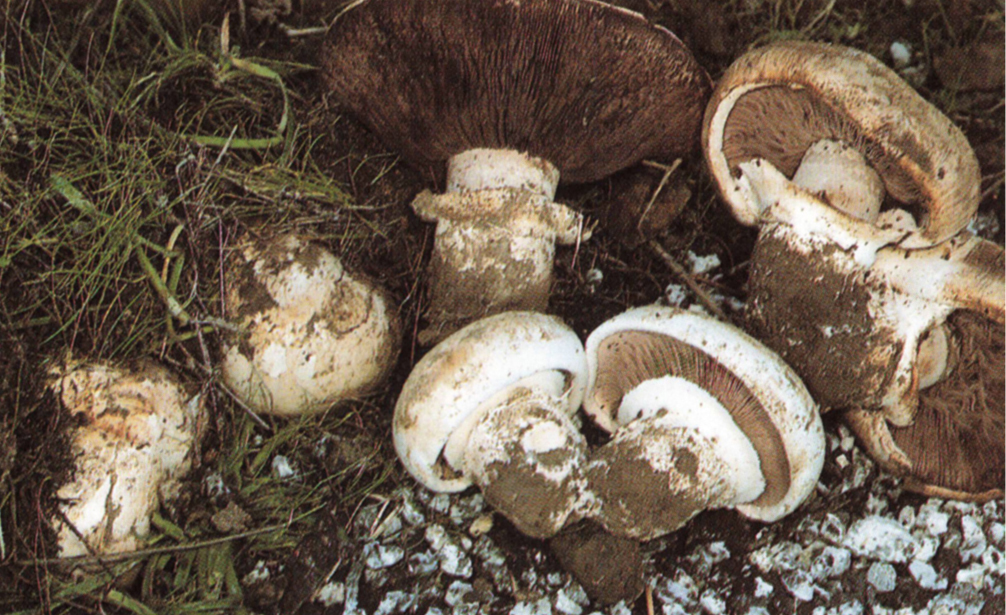
Other Names: Banded Agaricus, Urban Agaricus, Spring Agaricus, Agaricus rodmani.
Key Features:
1. Cap white to pale tan, bald, not yellowing when rubbed repeatedly, not sticky or slimy.
2. Gills free or nearly free from stalk, pinkish before veil breaks, dark chocolate-brown in age.
3. Flesh firm, staining only slightly if at all when cut.
4. Stalk hard, solid (neither hollow nor stuffed with a pith).
5. Veil present, at first covering the gills, then forming a prominent ring on stalk.
6. Ring bandlike (with both edges free or flaring) or sheathing (with only upper edge flaring), not skirtlike.
7. Base of stalk with a mild odor (not sweet or unpleasant) when crushed, not staining yellow when cut.
8. Developing underground (but often surfacing later).
Other Features: Medium-sized to fairly large; edge of cap tucked under when young, projecting beyond gills when older; flesh thick; stalk without a bulb at base; ring sometimes resembling a volva; spores chocolate-brown.
Where: Usually buried or half-buried in hard-packed or disturbed soil, silt, mud, or sometimes grass; widespread. In regions with cold winters it is most plentiful in the spring.
Edibility: Very firm and flavorful. One devotee goes so far as to say: “Life is like an Agaricus bitorquis — all good except for a few gills.” Life may not be so consistently good, but A. bitorquis certainly is!
Note: The names spring and urban agaricus reflect the preferred season and milieu, but several kinds of Agaricus are urban or grow in the spring. The bandlike or sheathing ring is more distinctive. See MD 321–322 for more information.

Ed Aguilar harvested 76 torks from this patch, but only a few are visible in this photo. That’s because the rest were underground, and had to be dug up like clams (see this page). Torks don’t normally grow in pastures, but this one was covered with a layer of silt from a recent flood.
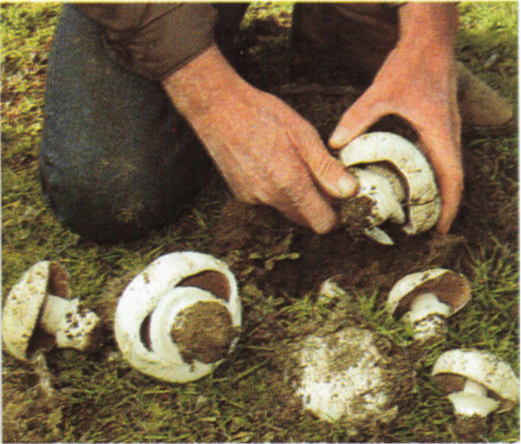
Knife and tork.
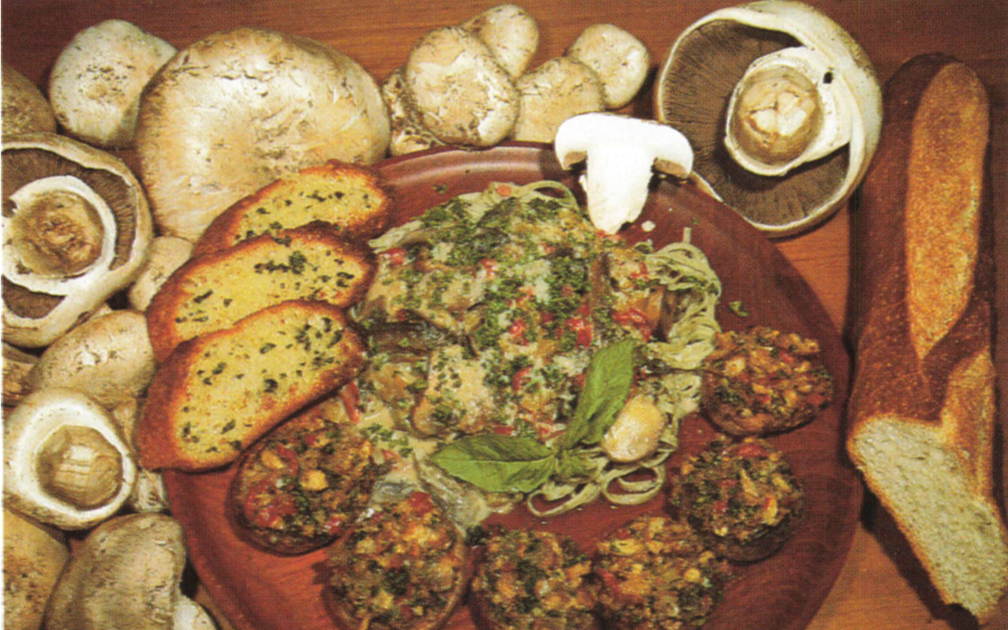
“We ate fabulously and got along famously” (see “Mining for Mushrooms,” this page). Torks are superb stuffed and broiled or sauteed and served over pasta.
Mining for Mushrooms
(to be said aloud)
It was a long time ago, in my hippie days. I was living on a commune, and I was sick and tired of all the bickering and brown rice. I really needed some space, so I split for Arizona, where I heard there was nothing but, to see the spring wildflowers. So get this: we’re driving down this crusty, dusty desert road on the way to a scenic overlook — the most unlikely place in the world for mushrooms — and I see this glimmer of white in the ditch by the road. We stop for a look and, sure enough, it’s an old Agaricus bitorquis. Jade says it must be the only shroom in the state of Arizona, and I’m about to agree when I start noticing all these cracks everywhere in the hard red clay along the road. It was shroom city. There were hundreds, big clumps of them, veins of them, but all underground! Most were several inches under, some more than a foot. “Dig this!” I said to Jade. “With what?” she wanted to know. We used our hands, making piles of them on the road as we walked along.
Of course we were noticed. An RV stopped, and this older couple from Long Beach got out and wanted to know what we were doing. “We’re mining for mushrooms,” I said, pausing for effect, “and we’ve just struck the mother lode.” We could tell they really wanted to try their hand at it. They sold life insurance and had been traveling for three months, visiting every national park in the country and this was their final stop, their last scenic overlook, and they were so burned out, they really wanted to do something exciting. But duty called, they just had to go on to the overlook.
Five minutes later they were back for some fun. Along with everything else in the world they had brand new shovels with them which they’d been wanting to use for months, and they started pulling giant buttons out of the ground like clams. Boy were they stoked! Mushrooms, edible mushrooms, under the sun-baked desert crust! It was totally incredible to them. It wasn’t in their tourist guides or on their itinerary, the auto club hadn’t said anything about it, it had never occurred to them to eat wild mushrooms, so they just got more and more excited and started scurrying around yelping and babbling like kids, “Look at this sonofagun over here!”; “Mine’s even bigger than yours!”; “Holy Cow, it’s hard as a rock!”; “I can’t believe I’m doing this!”
Another RV pulled over to see what all the commotion was about. One of them also sold insurance and of course they had shovels, so they dug right in. Then another RV joined us, a Mormon family from Moab, a bicyclist bound for Lubbock, and two local Navajo. We must have pulled up a couple hundred pounds, and we left lodes behind. Talk about “overlook” — we wouldn’t have gotten any if that one old cap hadn’t made it above the ground!
There was only one campground in the area and we were all staying there, so that night we had this incredible spontaneous mushroom feast with gourmet foods and drinks they’d stashed away in their RVs for that one really special occasion, and what could be more special than this? We ate fabulously and got along famously, and the couple from Long Beach wanted to know if this was what it was like to live communally and I said: “Sure, we do this every night.”
I guess you could say we made their day. In fact, they said it was the best thing that happened on their whole trip! We had more for breakfast the next morning, and sun-dried the rest, and that one couple just couldn’t stop talking about how excited they were. I kept getting letters from them afterwards, and I bet they’re still talking about it, twelve years later, telling their grandchildren about the mighty once-in-a-blue-moon shroom bloom beneath the Arizona desert. Me, I’m not much of a talker, but I’m sure tempted to go back — I never did make it to that scenic overlook!
—Max Lipp

“It was the most unlikely place in the world for mushrooms…”
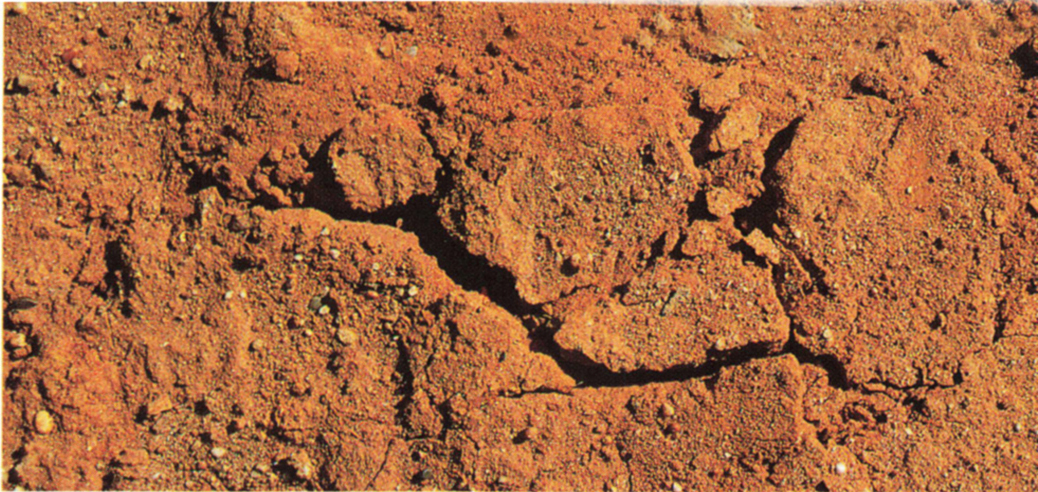
“Then I started noticing all these cracks everywhere in the hard red clay.”